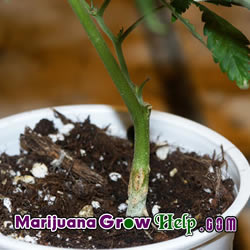Repotting Your Plants & Trimming the Root Ball

Repotting Marijuana
Like any good parent knows, as your child grows you have to buy a new wardrobe for them. Repotting gives your plant the new outfit it needs. As your precious plants grow all you need to do is re-pot them a handful of times and you’ll be set.
Successfully re-potting your plants can be as quick, easy and reasonably painless as you choose to make it. But the very first step to successful repotting is the soil blend you’ll use. When it comes time to re-pot your seedlings, you’ll want to use the exact same soil blend that you used to sprout them, so make sure to keep enough soil for re-potting, especially if you mix your own blend.
While it might seem like unnecessary extra effort, re-potting your plants can be beneficial for several reasons:
During re-potting, you can also trim the root ball of your plant. Trimming the root ball can be beneficial for a variety of reasons, but it can be particularly useful if you’re re-potting a sativa or sativa-hybrid just prior to flowering, and you want to encourage the plant to stay smaller.
When you trim the root ball, your plant will put more effort into re-growing its roots as opposed to developing more leafy foliage or taller limbs. With sativa strains being notoriously tall and wide, every little trick to keep your girls small can come in handy.
In any event, it’s best to time the re-potting of your plants to coincide with your watering cycle. Plants with moist or mostly dry soil will lift out of their pots more easily. Once you’ve re-potted your plants, it’s good to follow up with a healthy watering to reduce stress.
Some growers like to let their plants get slightly too big for their current pot / container, effectively allowing them to get slightly root bound before re-potting them into larger containers. In theory, the plants may then experience a surge of new growth when they are re-potted, but this is a tactic that new growers should steer clear from.
There are enough problems and new things to learn as a first-time grower, so it’s best not to needlessly complicate things by experimenting with uncertain theories you may have heard.





No comments yet.